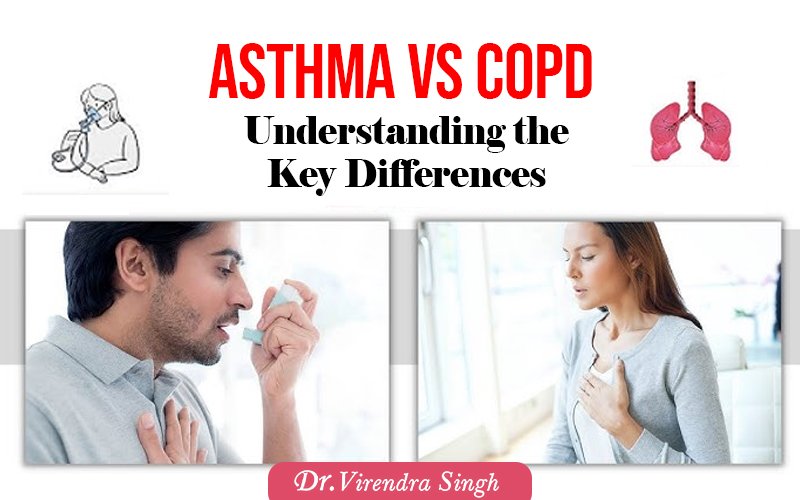
Don’t take your lungs for granted. They are essential for life, even if you don’t think about them. Your lung health must therefore be your first priority. By following these practical suggestions, you may maintain the health of your lungs and breathe more easily. Asthma and COPD are both chronic respiratory conditions, but they have different causes, symptoms, and disease patterns. Asthma usually starts in childhood and is associated with allergens. Its symptoms, such as wheezing and dyspnea, can change daily and get better with medicine or by avoiding triggers. In contrast, COPD, which encompasses emphysema and chronic bronchitis, typically strikes persons over 40 and is mostly brought on by prolonged smoking or exposure to dangerous chemicals.
Even with treatment, COPD symptoms—like a chronic cough and shortness of breath—tend to get worse with time and are less reversible than those of asthma. Dr. Virendra Singh explains that while both Asthma and COPD affect breathing, they are different in many ways. Asthma usually starts in childhood and is often related to allergies or dust, with symptoms like wheezing and coughing that can come and go. On the other hand, COPD primarily affects adults over 40, particularly those who smoke or have been exposed to pollutants for an extended period of time. It produces persistent coughing and dyspnea that gradually worsens.
What is Asthma?
A chronic inflammatory illness of the airways, asthma is characterized by hyperresponsiveness of the airway, which causes repeated episodes of coughing, chest tightness, wheezing, and dyspnea, often at night or in the early morning. These episodes, which are brought on by varying airflow restrictions, can end on their own or with medical intervention. Approximately 300 million people globally suffer from asthma.
Asthma can occur due to a number of reasons. While some people may have a hereditary predisposition to allergies and hyperresponsivity airways, other factors, like sex and weight, can also cause asthma. Further, environmental factors may include allergens, occupational sensitizers, lung infections, tobacco smoke, outdoor/indoor air pollution, and diet. Thus, asthma is not solely induced by inhalation of noxious gases and fumes alone.
What is COPD?
COPD is a chronic pulmonary disease with persistent airway obstruction. COPD is distinguished by reduced airflow that is not fully reversible. An abnormal inflammatory response of the lungs to harmful particles or gases is linked to airflow restriction, which is often progressive and gets worse with time. In COPD, the air sacs in the lungs lose their elasticity thus limiting the ability of the lungs to absorb oxygen adequately.
The third most common cause of death globally, COPD, is typically found in cigarette smokers and people who are exposed to the fumes from burning biomass for cooking and heating in homes with inadequate ventilation.
Symptoms
The symptoms of asthma and COPD frequently overlap, and it can be challenging to distinguish between the two conditions based solely on symptoms.
Symptoms of Asthma
The symptoms include the following:
- Coughing (mostly dry)
- Breathlessness
- Rattling in the lungs or chest
- Heaviness in the chest
- Labored breathing
- Wheezing
- Difficulty walking or talking
- Tightness in the neck or throat
Symptoms of COPD
The symptoms include the following:
- Chronic coughing
- Shortness of breath, especially during physical exertion
- Wheezing (less common)
- Tightness in the chest
- Unintended weight loss
- Fatigue
- Increased instances of respiratory infections
- Swelling of feet, ankles, or legs
- Presence of mucus in the cough (could be white, yellow, or greenish)
As previously stated, COPD also has systemic symptoms and co-morbidities, such as:
- Diabetes
- Hypoalbuminemia
- Heart failure
- Cognitive deficits
- Cachexia
- Cardiac arrhythmias
- Anemia
- Osteoporosis
- Body weight loss
- Skeletal muscle wasting
- Cardiac ischemia
- Depression
- Heart failure
Treatment
Adequate and consistent treatment will lower symptoms, prevent flare-ups, and enhance the patient’s overall quality of life in both asthma and COPD.
Treatment of Asthma
The ultimate goal of treating asthma is to restore complete control over respiratory symptoms by reducing airway inflammation. The most significant drugs for asthma patients are bronchodilators and inhaled corticosteroids (ICS), which help prevent exacerbations, improve pulmonary function, slow the course of the disease, reduce airway remodeling, and lessen the need for further medications.
Treatment of COPD
Treatment of COPD involves relieving breathlessness, the most bothersome symptom in COPD patients. Additionally, reducing mortality and decreasing exacerbations are further goals of COPD treatment. The mainstay of treatment for adults with COPD is long-acting bronchodilators. In COPD, ICSs are only useful in patients with repeated exacerbations, a history of asthma, and advanced COPD.
Early diagnosis and treatment of COPD and asthma can affect morbidity and death. Treatment costs would be decreased, and life quality would be enhanced. Early asthma and COPD diagnosis and therapy can reduce morbidity and mortality. Life quality would improve, and treatment expenditures would drop.
SUMMARY
The following criteria are usually looked at by clinicians for diagnosing asthma and COPD:
- Past History: Patients with COPD typically smoke, either currently or in the past, but those with asthma may have symptoms that started in childhood.
- Age: While asthma can start early in childhood, COPD often affects people over 40.
- Symptoms: Chronic coughing, coughing up phlegm, and worsening symptoms can all be signs of COPD. Frequent episodes are indicative of asthma, particularly when they are accompanied by eczema and allergic responses.
- Symptom Triggers: COPD symptoms may be triggered at any time, even when at rest. Asthma attacks of asthma usually happen in the early morning or at night and are triggered by allergens, environmental stimuli, and physical activity.
